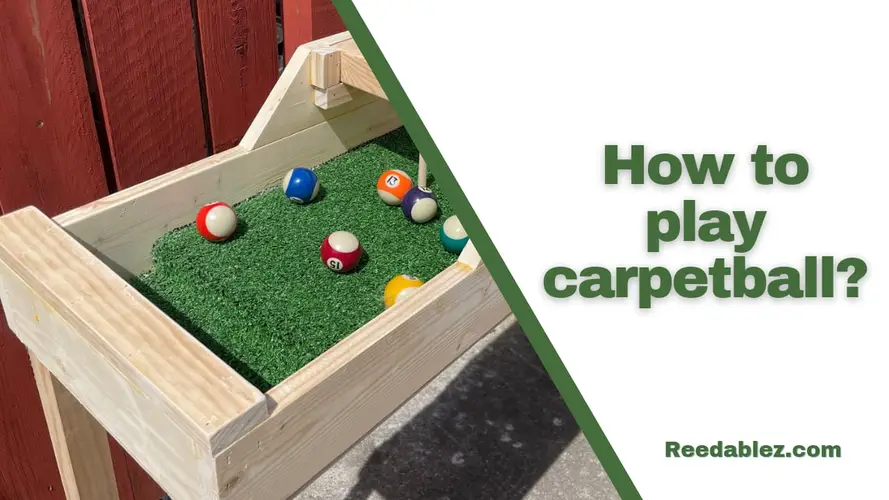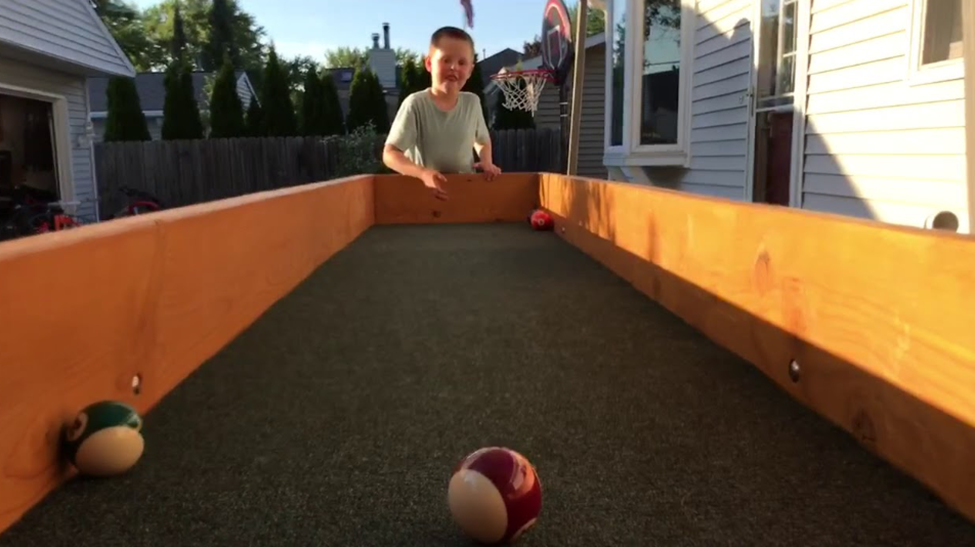How to make FiveM use less CPU? [A Comprehensive …
April 14, 2018

Carpetball, a delightful and social game, has gained popularity as a recreational activity, perfect for gatherings, parties, or friendly competitions. This guide aims to provide a comprehensive understanding of how to play carpetball, from the basic setup to advanced strategies. Carpetball originated in the United States in the late 20th century. Its invention is often credited to individuals seeking a casual and inclusive game that could be enjoyed by people of all ages.
To play carpetball, aim to score points by knocking opponent balls into pockets using a cue stick. Follow the basic rules, master techniques like straight and banking shots, and strategize for success. Enjoy this social game's inclusive and engaging nature for endless fun with friends and family.

In this article we will tell you how to play carpetball? and how long is a carpet ball table can be.
A standard carpetball table is typically rectangular, with dimensions ranging from 8 to 10 feet in length and 4 to 5 feet in width. The table's surface is covered with a durable carpet, providing the ideal playing field for the smooth movement of the balls.
Carpetball is played with a set of balls, usually six per player or team, and one cue ball. The balls are arranged in a triangular pattern at one end of the table, similar to the setup in traditional pool or billiards.
The primary goal in carpetball is to score points by successfully knocking the opponent's balls into the pockets on the sides of the table. The player or team with the highest score at the end of the game is declared the winner.
The game typically begins with a lag, where players simultaneously shoot their cue balls from the end of the table, aiming to have it return closest to them. The winner of the lag gets to choose whether to take the first shot or pick the ball they want to be.
Players take turns using the cue stick to hit their assigned balls. The objective is to knock the opponent's balls into the pockets, earning points based on the designated scoring system. The cue ball is used strategically to position the balls for optimal shots.
Common fouls in carpetball include hitting the cue ball off the table, sinking the cue ball or opponent's ball before all your balls are cleared, and striking the opponent's balls out of turn. Penalties may result in the opponent gaining the advantage.

In a single-player game, each player competes individually to score points against an opponent. The game is a test of individual skill, strategy, and accuracy.
Doubles mode introduces teamwork, where two players collaborate to score points collectively. Communication and coordination between team members are crucial for success in this format.
Mastering the straight shot is fundamental in carpetball. Players must develop accuracy and control to send the cue ball directly into the targeted ball, strategically positioning it for subsequent shots.
Banking shots involve bouncing the cue ball off the table's sides to hit balls at different angles. This technique is essential for navigating around obstacles or reaching balls in challenging positions.
In addition to offensive moves, understanding defensive strategies is crucial. Blocking opponent balls or strategically placing your balls in difficult positions can limit the opponent's scoring opportunities.
Experienced players understand the importance of controlling the center of the table. This strategic position allows for better access to opponent balls and provides opportunities to dictate the flow of the game.
Adept carpetball players analyze the placement of balls on the table meticulously. Identifying the optimal sequence for hitting balls and planning subsequent shots based on ball positions enhances strategic gameplay.
In doubles mode, effective communication between team members is paramount. Coordinating shot selections, discussing strategies, and adapting to the changing dynamics of the game contribute to a successful doubles partnership.
One common mistake is hitting the cue ball or opponent's ball out of turn. Maintaining order and respecting the sequence of play is crucial to a fair and competitive game.
Fouls can cost valuable points. Players must be mindful of the rules to avoid fouls such as sinking the cue ball prematurely or hitting opponent balls out of turn.
Strategic ball placement is essential for success. Placing your balls in favorable positions while hindering your opponent's options requires foresight and planning.
Maintaining a respectful turn order is a fundamental aspect of carpetball etiquette. Players should wait their turn patiently and allow opponents to complete their shots before taking their own.
Disputes can arise, but resolving them amicably is crucial. Clear communication, understanding the rules, and seeking consensus ensure a harmonious gaming experience.
Winning is part of the game, but celebrating victories with humility and sportsmanship reflects the true spirit of carpetball. Acknowledging opponents and appreciating the game fosters a positive atmosphere.
Organizing a carpetball tournament adds an exciting competitive element. Creating a bracket system with elimination rounds allows participants to vie for the title of champion.
Establishing clear tournament rules is essential for fairness and consistency. Rules regarding fouls, scoring, and conduct ensure a level playing field for all participants.
To enhance the competitive spirit, consider offering prizes for tournament winners. Prize ideas could range from trophies and certificates to gift cards or unique carpetball-themed items.
Regularly cleaning the table surface is crucial for optimal gameplay. Remove dust, debris, and spilled substances to maintain a smooth and consistent playing field.
Inspecting the condition of the carpetball and cue balls is necessary. Replace worn-out or damaged balls to ensure fair gameplay and prevent inconsistencies in ball movement.
Address any wear and tear on the table promptly. Repairing loose carpeting, damaged rails, or other components contributes to the longevity of the carpetball table.
Speed carpetball introduces a time element, challenging players to complete games within a specified duration. This variation adds a sense of urgency and excitement to the traditional game.
In obstacle carpetball, players navigate around obstacles strategically placed on the table. This variation tests players' adaptability and introduces a new layer of challenge to the game.
A carpetball table is a popular and versatile gaming surface that has gained popularity in recreational settings, providing entertainment for people of all ages. The standard dimensions of a carpetball table play a crucial role in the overall gaming experience. Let's delve into the specifics of the size of a carpetball table and its impact on gameplay.
The typical length of a carpetball table falls within the range of 8 to 10 feet, making it a compact yet substantial playing surface. This length is designed to accommodate the gameplay mechanics of carpetball effectively. The width of the table is generally between 4 to 5 feet, providing enough space for players to maneuver and execute their shots with precision.
While the standard dimensions provide a consistent playing experience, it's worth noting that variations exist. Some DIY enthusiasts may choose to build custom carpetball tables with unique dimensions, catering to specific preferences or spatial constraints. However, these custom tables often adhere to the fundamental principles of length and width to preserve the essence of the game.
Playing carpetball is a delightful blend of skill, strategy, and social interaction. The game's objective, to score points by skillfully maneuvering balls into pockets, creates an engaging experience suitable for players of all ages. The standardized dimensions of the carpetball table, combined with the use of durable carpeting, contribute to a smooth and dynamic gameplay. From basic rules to advanced strategies, carpetball offers a range of challenges, fostering continual improvement. Emphasizing etiquette and sportsmanship, carpetball isn't just a game; it's a shared experience that builds connections and leaves players with fond memories of spirited competition and camaraderie.
The primary goal of carpetball is to score points by knocking opponent balls into the pockets along the sides of the table using a cue stick. The player or team with the highest score at the end of the game wins.
Carpetball can be played in both single-player and doubles modes. In singles, individual players compete against each other, while doubles involve teams of two collaborating to score points collectively.
A standard carpetball table is rectangular, with dimensions ranging from 8 to 10 feet in length and 4 to 5 feet in width. The table surface is covered with durable carpet, and the game is played with a set of balls arranged in a triangular pattern.
The game typically begins with a lag, where players simultaneously shoot their cue balls to determine the starting order. The winner of the lag can choose to take the first shot or select the ball they want to be.
Players score points by successfully knocking opponent balls into the pockets. The specific scoring system may vary, but generally, points are awarded for each ball pocketed.
Common fouls include hitting the cue ball off the table, sinking the cue ball or opponent's ball before clearing all your balls, and hitting opponent balls out of turn. Fouls may result in penalties, impacting the flow of the game.
Yes, carpetball involves various techniques and shots. Players can employ straight shots, banking shots (bouncing off the table's sides), and defensive strategies to strategically position balls and limit opponent scoring opportunities.
With the rise of online platforms, you can explore virtual carpetball games and join enthusiast groups. These platforms allow players to enjoy carpetball remotely, share experiences, and even organize virtual tournaments.
Variations like Speed Carpetball, introducing a time element, and Obstacle Carpetball, involving navigating around placed obstacles, add exciting twists to the traditional game.
Comments
Write a comment